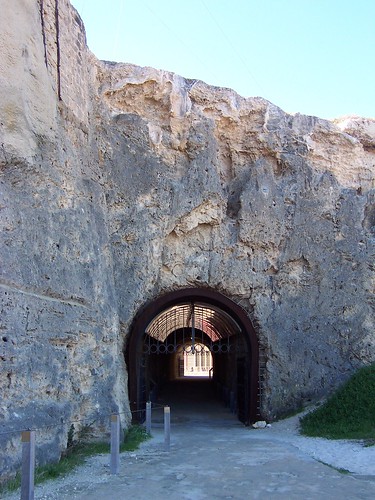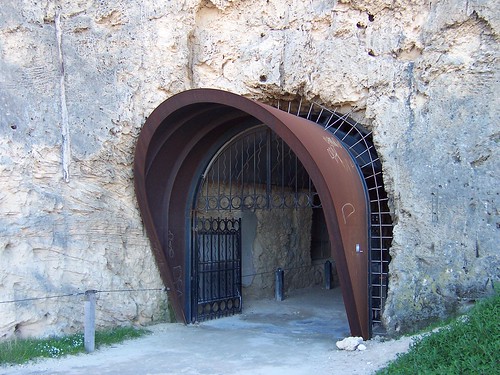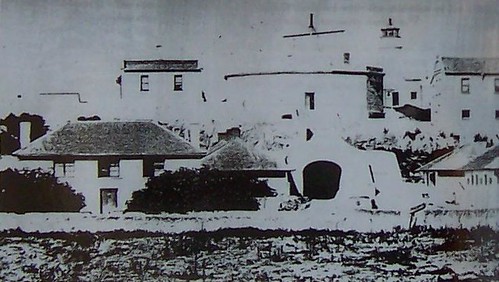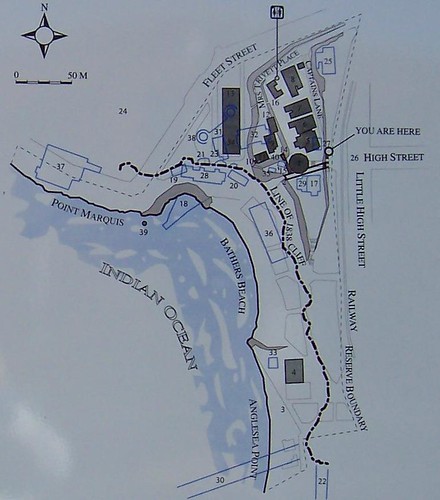
Under the Round House there's an old whalers' tunnel. It's from way back in the 19th century when Freo had a whaling station.
From the sea side, looking through at a building on High Street. The Round Hose is on top to the left of the edge of this photo. (Map includes archaeological sites)
It was built by the Freo Whaling Company in 1837 or 38 for easy access to the town. Bathers Beach was the original port part of the town so that makes sense. Otherwise they would've had to lump stuff all the way up and over the cliff or round it.
"The Whalers' Tunnel was the first underground engineering project in Western Australia," one of the little history plaques says, "and the government provided engineering expertise and convict labour to build it.
Originally the tunnel was 3.6 metres high and 64 metres long. Quarrying of the western cliff [picture above] of Arthur Head has reduced this length to 46 metres. The limestone excavated during construction was used to build the whaling station jetty."

Same plaque:
"The much smaller 'Secret Tunnel', which can be seen branching from this tunnel, was constructed in 1938 to provide quick access from the Gunner's Cottage on the upper level to the Whalers' Tunnel, which was used as an air raid shelter in World War II.
Wrought iron gates were installed at the ends of the tunnel in the 1930s as part of an attempt to beautify the area."
A round house on a cliff with a secret tunnel! How very Biggles!

You can see the tunnel clearly in this circa 1850-69 photo. Above it is the wide shape of the Round House and the signal mast above it. The other buildings are listed on the map.

Looking across the railway tracks, through the tunnel and out to Gage Roads and the sea.
There's a mention of Australia's whaling industry in Herman Melville's 1851 novel Moby Dick:
"That great America on the other side of the sphere, Australia, was given to the enlightened world by the whaleman. After the first blunder-born discovery by a Dutchman, all other ships long shunned these shores as pestiferously barbarous; but the whale-ship touched there. The whale-ship is the true mother of that now mighty colony."
The Dutchman is either Willem Janszoon or Abel Tasman. The Dutch mapped a bit of the coastline of Australia around the 1600s-1700s, called it New Holland and buggered off home.
More history stuff:
"Arthur Head is a remnant coastal limestone cliff of wind blown sand on fossil coral reef.
For the Nyungar, it is associated with Waugal (who created the Swan River) and Walja (Eaglehawk).
Arthur Head was the landing place of the first [white] settlers of the Swan River Colony. Arthur Head is a significant heritage site where Fremantle and the Swan River Colony started and represents several post contact development themes including:
Maritime and port uses (1829-1850s, 1870s)
Whaling and boat building (1837-1860s)
Law and order (1830-1850s, 1870s)
Defence (1900s, 1930s-1940s) and
Industry (1880s-1920s).
The area was used as a maritime port, a whaling and boat building station, a centre for justice, a defence post and has had several industies.
Captain James Stirling, Henry William Reveley, Philip Snell-Chauncey, James Austin and Hilson Beasley are associated with the development of the area.
The map [below] indicates the existing sites associated with the many uses of Arthur Head Reserve."

(Go back to where you came from)
"EXISTING BUILDINGS [shaded]
1 Roundhouse, well and bakehouse (1831)
2 Whalers' Tunnel (1831)
3 Sea wall (c1873)
4 Kerosene store (1884)
5 Pilot's cottage No 9 (1904)
6 Pilot's cottage No 10 (1904)
7 Pilot's cottage No 11 (1904)
8 Pilot's cottage No 12 (1904)
9 Gunner's cottage (1904)
10 Gunner's cottage (1904)
11 Artificer's store (c1909)
12 Laboratory (c1912)
13 J Shed (c1912 - relocated from Victoria Quay c1968)
14 Secret tunnel (c1938; WWII)
15 Signal mast & timbeball (1986/88)
16 Toilet block
ARCHAEOLOGICAL SITES [blue lines]
17 First courthouse (1835 - <1869)
18 Whalers' Jetty (c1837 - 1870s)
19 Tryworks (c1837 - 1900, 1930?)
20 Stationhouse (c1837 - >1887)
21 Cave stores (c1838 - c1887)
22 South Jetty (c1847 - 1929)
23 Scound lighthouse (1876 - 1903)
24 Magazine (c1850 - 1895)
25 Government cottage (c1850 - c1966)
26 Police Station complex (c1850 - 1895)
27 Second courthouse (1851 - 1903)
28 Mews boatshed (1856 - <1945)
29 Harbourmaster's house (<1869 - 1928)
30 Long Jetty (c1873-1921)
31 First lighthouse (c1850-c1903)
32 Lightkeeper's quarters (c1844 - 1904)
33 Mortuary (c1896 - 1922)
34 Time Ball (1900 - 1937)
35 Signal Station (c 1902 - 1929) & WWII Observation Post (c1929 - 1962/67)
36 Fruit shed (c1904 - 1974)
37 Power House (1905 - 1906)
38 Gun Emplacements (190 - 1966)
39 Gun Emplacements Base (Relocated c1967)
40 Signal Mast No.2 (c1905 - c1975)"
(Go back to where you came from)
6 comments:
Good stuff Spike... very nicely done! Thanks for showcasing this side of Oz... under the circumstances I reckon I'd owe you a beer of three for the why.
Good shots mate... cheers
agree - good stuff, I like history. Liked Freo too, want to go back one day for another look, they do good sunsets over there :)
Belongum - I may just take you up on that when next I'm there.
Yer welcome. And there's more where that came from. When I get off my bum and post it.
Erica - It's a pleasant town. Didn't see much of the sunsets while I was there but it was good to have a bit of a wander about the streets. You know people around Freo?
Wow, fascinating post. I'm actually about 3/4 of the way through Moby Dick right now, so this was nice timing :-)
Excellent.
Never read that myself. It's on of those Must Read To Appear Well Read books. I gather it's about a whale and a bloke and in the end they go off together.
I got here much interesting stuff. The post is great! Thanks for sharing it! Weekend Markets Sydney
Post a Comment